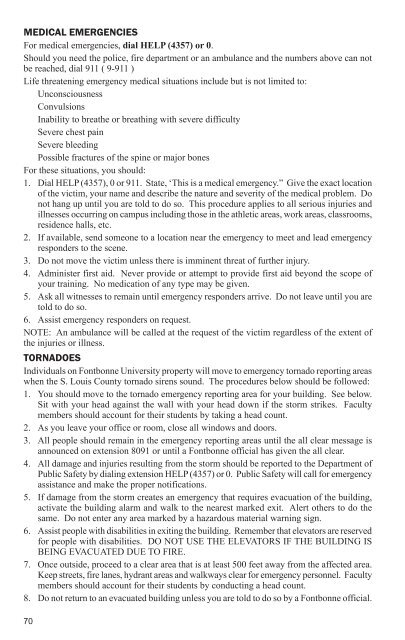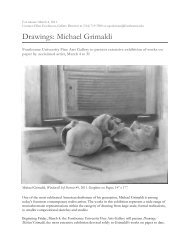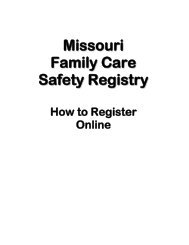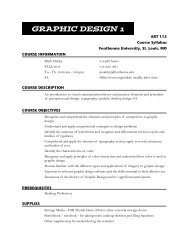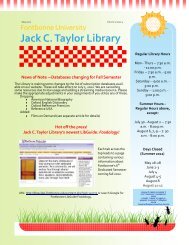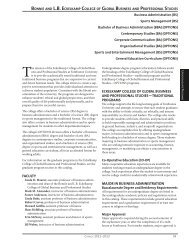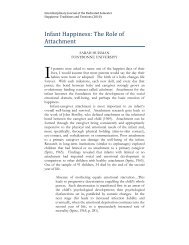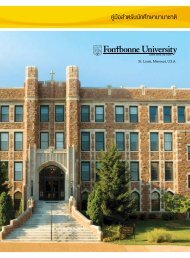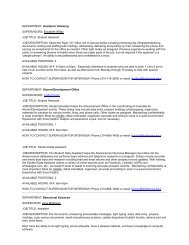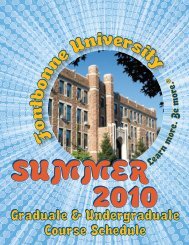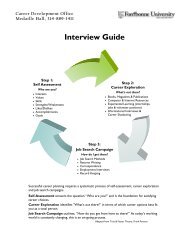Click here (pdf, 891.09KB) - Fontbonne University
Click here (pdf, 891.09KB) - Fontbonne University
Click here (pdf, 891.09KB) - Fontbonne University
You also want an ePaper? Increase the reach of your titles
YUMPU automatically turns print PDFs into web optimized ePapers that Google loves.
MediCAl eMerGenCies<br />
For medical emergencies, dial HELP (4357) or 0.<br />
Should you need the police, fire department or an ambulance and the numbers above can not<br />
be reached, dial 911 ( 9-911 )<br />
Life threatening emergency medical situations include but is not limited to:<br />
Unconsciousness<br />
Convulsions<br />
Inability to breathe or breathing with severe difficulty<br />
Severe chest pain<br />
Severe bleeding<br />
Possible fractures of the spine or major bones<br />
For these situations, you should:<br />
1. Dial HELP (4357), 0 or 911. State, ‘This is a medical emergency.” Give the exact location<br />
of the victim, your name and describe the nature and severity of the medical problem. Do<br />
not hang up until you are told to do so. This procedure applies to all serious injuries and<br />
illnesses occurring on campus including those in the athletic areas, work areas, classrooms,<br />
residence halls, etc.<br />
2. If available, send someone to a location near the emergency to meet and lead emergency<br />
responders to the scene.<br />
3. Do not move the victim unless t<strong>here</strong> is imminent threat of further injury.<br />
4. Administer first aid. Never provide or attempt to provide first aid beyond the scope of<br />
your training. No medication of any type may be given.<br />
5. Ask all witnesses to remain until emergency responders arrive. Do not leave until you are<br />
told to do so.<br />
6. Assist emergency responders on request.<br />
NOTE: An ambulance will be called at the request of the victim regardless of the extent of<br />
the injuries or illness.<br />
tornAdoes<br />
Individuals on <strong>Fontbonne</strong> <strong>University</strong> property will move to emergency tornado reporting areas<br />
when the S. Louis County tornado sirens sound. The procedures below should be followed:<br />
1. You should move to the tornado emergency reporting area for your building. See below.<br />
Sit with your head against the wall with your head down if the storm strikes. Faculty<br />
members should account for their students by taking a head count.<br />
2. As you leave your office or room, close all windows and doors.<br />
3. All people should remain in the emergency reporting areas until the all clear message is<br />
announced on extension 8091 or until a <strong>Fontbonne</strong> official has given the all clear.<br />
4. All damage and injuries resulting from the storm should be reported to the Department of<br />
Public Safety by dialing extension HELP (4357) or 0. Public Safety will call for emergency<br />
assistance and make the proper notifications.<br />
5. If damage from the storm creates an emergency that requires evacuation of the building,<br />
activate the building alarm and walk to the nearest marked exit. Alert others to do the<br />
same. Do not enter any area marked by a hazardous material warning sign.<br />
6. Assist people with disabilities in exiting the building. Remember that elevators are reserved<br />
for people with disabilities. DO NOT USE THE ELEVATORS IF THE BUILDING IS<br />
BEING EVACUATED DUE TO FIRE.<br />
7. Once outside, proceed to a clear area that is at least 500 feet away from the affected area.<br />
Keep streets, fire lanes, hydrant areas and walkways clear for emergency personnel. Faculty<br />
members should account for their students by conducting a head count.<br />
8. Do not return to an evacuated building unless you are told to do so by a <strong>Fontbonne</strong> official.<br />
Tornado Reporting Areas<br />
Dunham Student Activity Center ................. Training room, northwest stairwell, walkway to<br />
weight room<br />
East Building ................................................ 1st floor hallways<br />
Fine Arts Building ........................................ 1st floor restrooms and lower level hallways<br />
Library .......................................................... Basement<br />
Medaille Hall ............................................... Basement, Mezzanine Lounge and bathrooms<br />
between suites<br />
Physical Plant Area ...................................... Tunnel and basement<br />
Ryan Hall ..................................................... 1st floor hallway near room 105, hallway near<br />
book store<br />
Anheuser Busch Hall ................................... 1st floor hallway, men’s bathroom on 1st floor<br />
and 1st floor stairwells<br />
St. Joseph’s Hall ........................................... Hallway between lounges<br />
helpFul inForMAtion<br />
tips For suCCeedinG At <strong>Fontbonne</strong><br />
While it may seem that many of the following statements are common sense for many students,<br />
experience tells us that they are not common sense to all of us. T<strong>here</strong>fore, the undergraduate<br />
academic committee offers these points to help you progress through <strong>Fontbonne</strong> smoothly. Take<br />
advantage of any assistance you can find. Ask questions about any concerns you may have.<br />
Keep asking questions until you find the answers you need to succeed at <strong>Fontbonne</strong>. Please<br />
remember that in college, more than high school or any previous educational experience, the<br />
major responsibilities for success rest first and foremost with the student.<br />
ACAdeMiC Advisor<br />
Get to know your academic advisor immediately! Your advisor is t<strong>here</strong> to guide and support<br />
you, not to tell you what to do and not to do your work for you. Take the opportunity to meet<br />
with your advisor at times other than just during the pre-registration (early advising) and<br />
registration weeks. See your department chairperson or the director of academic advising if<br />
you’re not sure who your advisor is. Your advisor and your department chairperson are your<br />
two key contacts in addition to your instructors.<br />
AttendAnCe<br />
• Attend classes. Attendance plays a very critical role in your success in college.<br />
• Pay close attention to the attendance/participation policy as stated on each course<br />
syllabus. If t<strong>here</strong> is no attendance policy stated on the syllabus, ask the instructor about it.<br />
• Be aware that many classes may include in-class projects that if missed may result in points<br />
lost.<br />
• Note that attendance means coming to class on time and being prepared (books, assignments,<br />
lab manuals).<br />
syllAbi<br />
• Instructors are required to provide each student with a syllabus for each course. A syllabus<br />
is a detailed outline of how the course will progress and delineates what the instructor<br />
expects from each student. It may be presented as a hard copy or online.<br />
• Read the course syllabus carefully. Ask questions of the instructor if you are not clear<br />
on the meaning of any items. Do not expect the instructor to point out assignments, due<br />
dates, grading policies and the like.<br />
• Be responsible for all changes announced in class whether or not you attended the day<br />
of the announcement.<br />
70 71


